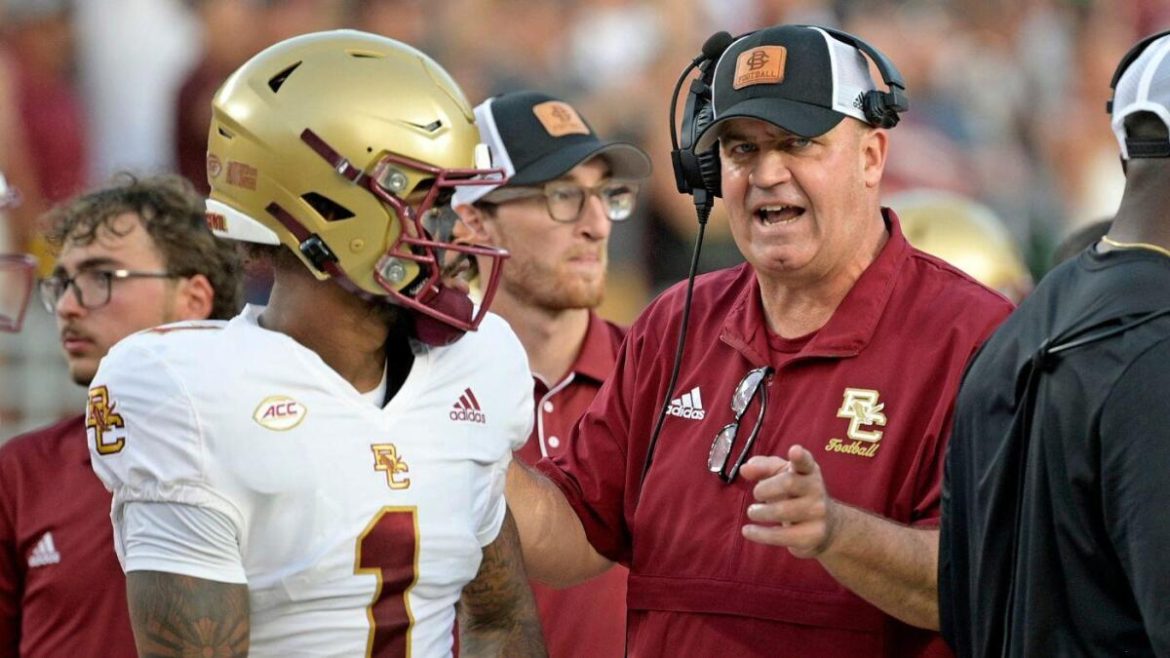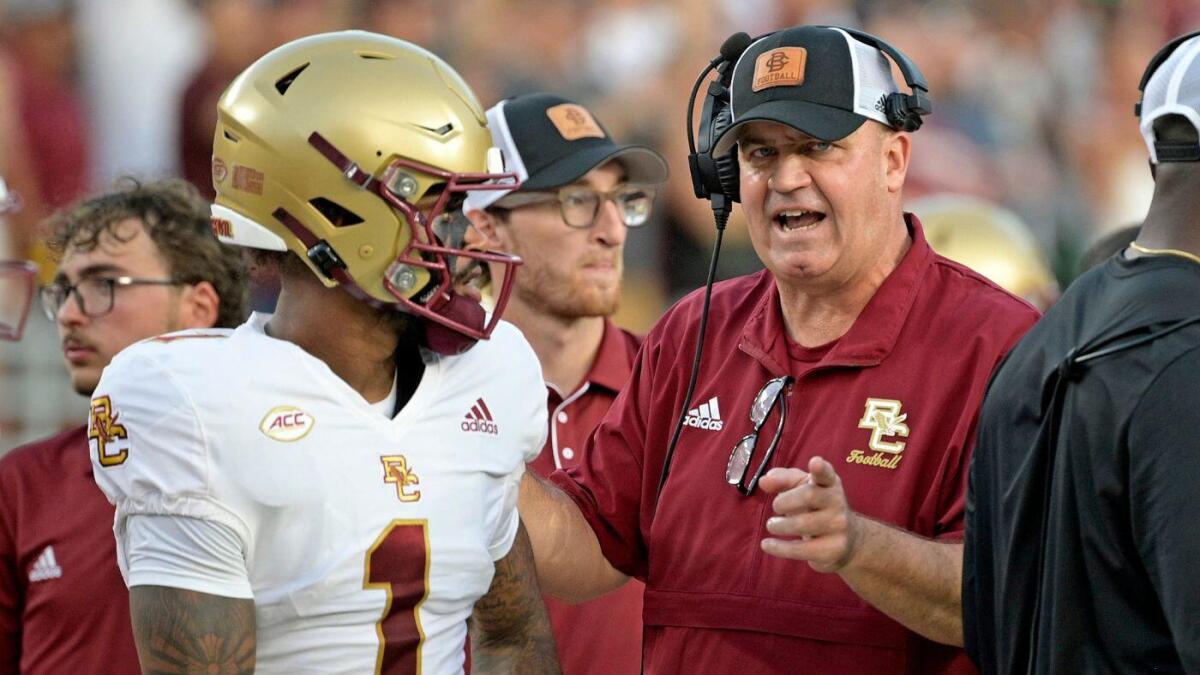The Quarterback Controversy: A Breakdown of the O’Brien-Castellanos Fallout
Introduction: A Clash of Titans
The world of college football is no stranger to drama, but few controversies have captured the attention of fans and analysts quite like the public fallout between former Boston College head coach Bill O’Brien and quarterback Thomas Castellanos. What began as a simple transfer decision quickly escalated into a full-blown media frenzy, complete with public accusations, rebuttals, and a heated exchange of words. This report aims to dissect the events leading up to the controversy, analyze the perspectives of both parties, and explore the potential implications for their respective careers and the broader landscape of college football.
The Seeds of Discord: Castellanos’s Time at Boston College
Thomas Castellanos arrived at Boston College with a reputation as a promising young quarterback, having demonstrated flashes of brilliance during his high school career. His tenure at BC was marked by both highs and lows, a common experience for young quarterbacks navigating the complexities of college football. Under the guidance of former head coach Jeff Hafley, Castellanos showed potential, but his trajectory took an unexpected turn when Hafley departed for the NFL.
The departure of Hafley, who had recruited Castellanos to BC, left a void in the quarterback’s development and support system. This event appears to have been the catalyst for a series of events that ultimately led to Castellanos’s transfer. The change in coaching staff often brings about shifts in strategy and player roles, and Castellanos found himself at the center of these changes.
The Benching and the Breakup: A Turning Point
The situation escalated when Bill O’Brien, the new head coach at Boston College, made the decision to bench Castellanos in favor of Grayson James. This move proved to be a pivotal moment, triggering a chain reaction that resulted in Castellanos stepping away from the team. While the initial reports suggested a mutual parting, the narrative soon shifted as both O’Brien and Castellanos began to voice their perspectives publicly.
The benching of Castellanos was a significant moment, not just for the quarterback but for the entire team. It raised questions about O’Brien’s coaching style and his ability to manage player relationships. The decision to bench Castellanos was seen by some as a bold move, while others viewed it as a potential misstep that could have long-term consequences for the program.
Castellanos Speaks Out: “I Wasn’t Repaid the Right Way”
After transferring to Florida State, Castellanos opened up about his reasons for leaving Boston College. In an interview, he expressed feeling “not repaid the right way,” suggesting a lack of support or opportunity under the new coaching regime. He implied that O’Brien played a significant role in his decision to transfer, indicating a breakdown in their relationship and a divergence in their vision for the team’s future.
Castellanos directly challenged the narrative that he quit on his team, arguing that the circumstances surrounding his benching and the subsequent lack of support forced his hand. He felt the need to find a program where his talents would be better utilized and appreciated. His comments highlighted the importance of player-coach relationships and the impact they can have on a player’s decision to transfer.
O’Brien’s Rebuttal: Accusations of Quitting
Bill O’Brien, known for his straightforward and sometimes blunt communication style, didn’t shy away from responding to Castellanos’s claims. He reportedly referred to Castellanos as an “outlier” and didn’t hold back when discussing the quarterback’s midseason departure. O’Brien directly contradicted Castellanos’s version of events, suggesting that the quarterback had, in fact, quit on the team after losing his starting job.
O’Brien emphasized that Castellanos’s decision to leave negatively impacted the team and disrupted the team’s chemistry. He implied that he had made the decision to bench Castellanos because he believed Grayson James offered a better chance for the team to win. O’Brien’s response underscored the complexities of coaching decisions and the potential fallout that can occur when players and coaches have differing opinions on a player’s role within the team.
Trading Barbs: A Public Spat
The back-and-forth between Castellanos and O’Brien quickly escalated into a public spat, with both sides trading barbs through media outlets. This created a media frenzy, fueling speculation and debate among fans and analysts. The controversy added fuel to the fire of the already intense rivalry between Boston College and Florida State.
The public nature of the dispute highlighted the challenges of managing player-coach relationships in the age of social media and 24-hour news cycles. It also raised questions about the role of the media in amplifying conflicts and the potential impact on the reputations of both coaches and players.
The Impact on Boston College
O’Brien’s decision to bench Castellanos and the subsequent controversy undoubtedly impacted Boston College. While some argue that the team improved after the quarterback change, the public dispute could have created a distraction and potentially affected team morale. Furthermore, O’Brien’s handling of the situation could influence future recruits’ perceptions of the program.
The controversy also raised questions about O’Brien’s coaching style and his ability to manage player relationships. Potential recruits may question O’Brien’s player management skills and his ability to foster a positive team environment. The situation serves as a reminder of the importance of clear communication and mutual respect in the coaching process.
Castellanos’s New Chapter at FSU
For Thomas Castellanos, the transfer to Florida State represents a fresh start and an opportunity to prove himself in a new environment. He has already begun turning heads at FSU, impressing coaches and teammates with his talent and work ethic. This new beginning could be a chance for Castellanos to showcase his skills on a bigger stage.
The transfer portal has become an increasingly important tool for players seeking new opportunities, and Castellanos’s decision to transfer highlights the benefits and challenges of this process. While the transfer portal can provide players with more agency and freedom, it also creates the potential for increased instability and turnover. Coaches must now navigate the delicate balance between maintaining a cohesive team and accommodating players’ individual aspirations.
The Underlying Issues: Coaching Styles and Player Expectations
The O’Brien-Castellanos fallout highlights the complex dynamics between college coaches and players. It underscores the importance of clear communication, mutual respect, and shared vision. Different coaching styles and varying expectations can often lead to friction and conflict, especially in high-pressure environments like college football.
In this specific case, it appears that there was a fundamental disconnect between O’Brien’s vision for the team and Castellanos’s expectations for his role within the program. The situation serves as a reminder of the importance of aligning expectations and fostering open lines of communication between coaches and players.
Navigating the Transfer Portal Era
The rise of the transfer portal has further complicated these dynamics, giving players more agency and freedom to seek out new opportunities. While the transfer portal can be beneficial for both players and programs, it also creates the potential for increased instability and turnover. Coaches must now navigate the delicate balance between maintaining a cohesive team and accommodating players’ individual aspirations.
The transfer portal has also raised questions about the role of coaches in the transfer process. Coaches must be mindful of the potential impact of their decisions on player morale and team chemistry. They must also be prepared to manage the media and public perception of their programs in the age of social media and 24-hour news cycles.
Conclusion: A Cautionary Tale
The Thomas Castellanos-Bill O’Brien saga serves as a cautionary tale about the potential pitfalls of miscommunication, differing expectations, and the complexities of the modern college football landscape. While both individuals have moved on to new chapters in their careers, the controversy serves as a reminder of the human element in sports and the importance of fostering positive relationships between coaches and players.
Ultimately, this situation highlights the need for empathy, understanding, and effective communication in navigating the ever-evolving world of college athletics. It also underscores the importance of clear communication and mutual respect in the coaching process. The O’Brien-Castellanos fallout serves as a reminder that the world of college football is not just about wins and losses, but also about the relationships and dynamics that shape the experiences of the players and coaches involved.





